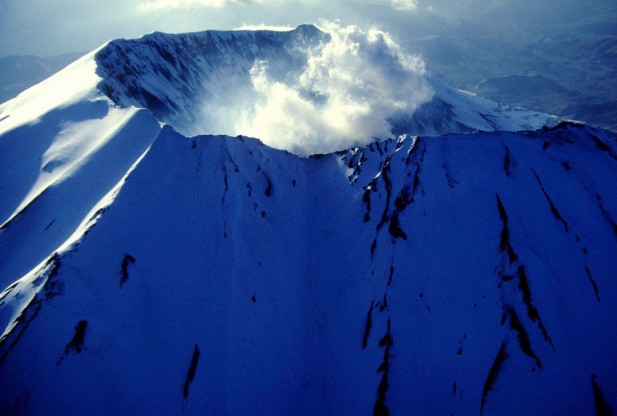
© ThinkstockThe snow-capped crater of Mount St. Helens.
Ten years ago Wednesday, Mount St. Helens in Washington erupted after being quiet for nearly two decades, and now US Geological Survey (USGS) scientists are concerned that the volcano could mark the occasion by becoming active once again, various media outlets reported over the weekend.
The volcano reawakened in September 2004 and erupted on October 1, remaining active until late January 2008, according to the
USGS. That event began with relatively small ejections of ash, which were followed by over three years of continuous slow lava extrusion - a stark contrast to the catastrophic May 1980 eruption that killed 57 and caused over $1 billion in damage.
"Since that time, scientists have been heavily monitoring the area to pinpoint when the next eruption will take place," said Tara West of
Inquisitr News. Experts expect "future dome-building eruptions at the volcano," and while they are uncertain exactly when that could occur, Mount St. Helens is starting showing signs of activity, she added.
"It looks like Mount St. Helens is getting ready to erupt again and it can happen in the order of years to decades," USGS seismologist Seth Moran told the
Associated Press on Sunday. Moran and USGS geologist Dan Dzurisin went on to explain that there are signs indicating the magma chamber that fueled the 2004-08 eruptions is recharging, and that the agency is monitoring that activity.
Moran and Dzurisin explained that the agency is focusing on the rate of recharge, and is looking to see whether or not the magma will be able to compress in the chamber instead of flowing towards a surface outlet. While the USGS said they were able to predict the eruption of 10 years ago by monitoring earthquakes in the region, Moran noted that the volcanic activity "exposed some weaknesses in our monitoring."
The eruption that started in 2004 was the second of two dome-building phases, the first of which began following the 1980 event, according to the AP. The second lava dome appeared at a different location in the crater, and the lava which appeared during the most recent eruption was far more solid than that observed during the earlier phase.
Despite the recent lack of eruption, the lava dome's shape is still changing, the wire service added. It fractures as it cools, causing it to settle and fall apart, Dzurisin explained. The shape of the crater rim has also been altered by falling rocks. Over the past few centuries, Mount St. Helens has gone through phases of explosive eruptions followed by phases of rebuilding, scientists said, and future dome-building eruptions are expected to occur there.
Moran told the AP that it appears as though the volcano is preparing to erupt again, and that the eruptions will likely be closer in nature to the one which started in 2004 and not its more destructive predecessor. Ultimately, its crater is expected to fill in, returning Mount St. Helens to the more rounded shape it had prior to 1980.
"It will rebuild itself. It may just take a lot longer to get there," the USGS seismologist said.
In the meantime, the agency has issued an
advisory recommending that residents and businesses in the region be "aware of potential future hazards and consult with local emergency-management agencies for advice on how to prepare for volcano and other types of natural hazards," and that renewed activity at Mount St. Helens could include "resumption of lava-dome growth, eruption of basaltic or
andesitic tephra and lava flows, explosive eruptions of dacitic tephra and pyroclastic flows, and large lahars that sweep down valleys heading on the volcano."
Reader Comments
to our Newsletter